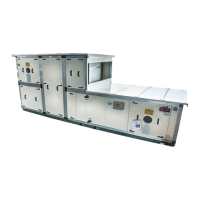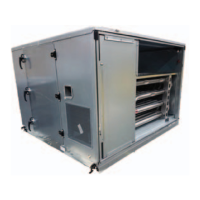Receiving
All of TRANE Quantum
TM
Air Handler are identified by a
multiple-character model number. lts use enables owner/
operator, installing contractors, and service technicians to
define the operation, components and options for a particular
unit. Be sure to refer to the information printed on the unit
nameplate (Figure1) when ordering replacement or
requesting service.
All unit sections are securely fasten to skids for shipping and
handling purpose.
Upon receipt of the unit(s), inspect for damage that may have
occurred during shipment and any items, which were ordered
but did not arrive with the unit. Complete the following checks:
1.
2.
3.
4.
5.
If damage is found or items are missing:
1.
2.
3.
4.
5
Report all claims of shipping damage to the delivering
carrier (transporter) immediately, and schedule an
inspection.
Make specific notations concerning the damage on the
freight bill.
Keep damaged material in the same location as received.
It is the receiver’s responsibility to provide reasonable
evidence that damage was not incurred after delivery.
Photograph the damages.
Do not move or discard damaged freight packaging
materials.
Notify the Trane sales representative of the damage and
arrange for repair. Do not attempt and arrange for repair.
Do not attempt to repair the unit without consulting the
sales representative.
When storing a TRANE Quantum
TM
Air Handler, for a period
of time before installation, it must be protected. The warranty
will not cover damages to the unit do to negligence during
storage. Indoor storage is ideal and requires only a few
special precautions.
To protect the unit from damage due to the elements and
prevent it from possibly becoming a contaminant source for
indoor air quality (IAQ) problems, the unit should be stored
indoors.
When outdoor storage is necessary, several things must be
done to prevent damage.
Nameplate Resolving Shipping Damage
Select a well-drained area, preferably a concrete pad or
blacktop surface.
Place the unit(s) on a dry surface or raised off the ground
to assure adequate air circulation beneath unit and to
assure that no portion of the unit contacts standing water
at any time.
Allow proper clearance around the unit to perform periodic
inspection and maintenance of the equipment while in
storage.
Keep the equipment in the original shipping container for
protection and ease of handling.
Cover the unit securely with a CANVAS tarp.
Ensure that the canvas tarp is secure.
Do not stack units.
Do not pile other material on the units.
Loosen belt tension on drive belts.
1.
2.
3.
4.
5.
6.
7.
8.
9.
Outdoor Storage
Storage Considerations
Delivery Check
Visually inspect the exterior unit casing and all
accessories for any dents, punctures or shipping and
handling damage.
Cut all banding (if applicable) loose from skid, but do not
remove the skids.
Check all access doors to confirm that they are secured
with latches.
Manually rotate the fan wheel to ensure free movement of
the shaft and bearings Inspect the fan housing for any
foreign objects.
Inspect the coil(s) for fin damage.
7
Figure 1

